#piotr szapocznikow
Explore tagged Tumblr posts
Text

Alina Szapocznikow, Glowa Piotra / Head of Piotr, 1972. Polyester, 18 1/2 x 18 1/2 x 7 1/16 inches.
145 notes
·
View notes
Text

Alina Szapocznikow, 'Illuminated Woman', 1966-1967, plaster, colour polyester, electric light, 155 x 57 x 40 cm. Courtesy of Piotr Stanislawski and Galerie Gisela Capitain GmbH, Cologne, photo WIELS | @abwwia
14 notes
·
View notes
Photo
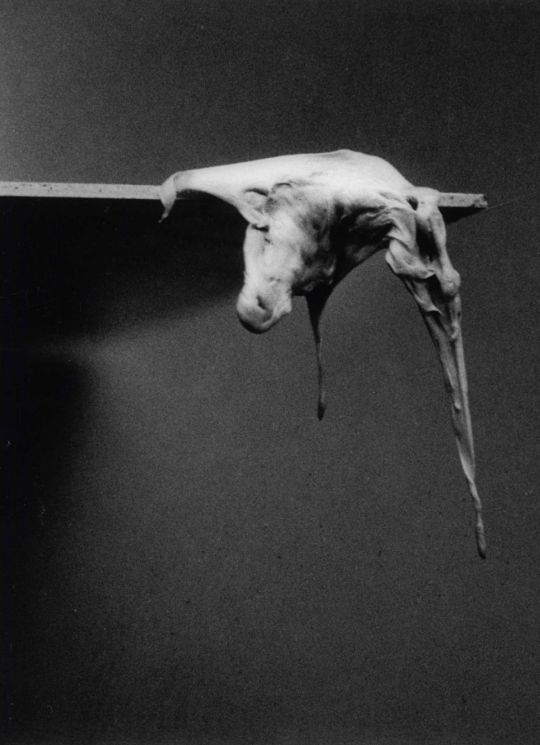
Alina Szapocznikow, 'Photosculpture' (1971, reprinted 2007)
Courtesy Piotr Stanislawski / Estate Alina Szapocznikow
Polish sculptor Alina Szapocznikow (1926-73) coined the term photosculpture in 1971 to describe these unique close-up images of blobs of chewing gum, manipulated into curious shapes in the artist’s mouth and attached to concrete or wooden supports.
#art#sculpture#abstract art#abstract#alina szapocznikow#photosculpture#poland#chewing gum#gum#chewing#piotr szapocznikow#chronic mastication#mastication#forms#texture#blob
31 notes
·
View notes
Text

Alina Szapocznikow, Piotr, 1972
Polyester resin, 205 x 45 x 33 cm

Fiancée filler (Mad fiancée), 1971
Polyester resin, 17.5 x 48 x 16 cm
Human landscapes, gender-shift

Untitled, c. 1971-72
Pencil on paper, 29.5 x 21 cm
2 notes
·
View notes
Photo

Alina Szapocznikow, Kuzlowa [Maternité], 1969, assemblage polyester photographies couleur, gaze, 42 x 52 x 18 cm, © Piotr Stanisławski.
28 notes
·
View notes
Photo

Alina Szapocznikow, Sans titre (Untitled) (1964–1965). Plaster. 13 x 7.7 x 3.5 cm 5 1/8 x 3 1/16 x 1 3/8 inches. © ADAGP, Paris. Courtesy the Estate of Alina Szapocznikow / Piotr Stanislawski / Galerie Loevenbruck, Paris / and Hauser & Wirth. Photo: Fabrice Gousset.
51 notes
·
View notes
Text

Autoportrait I
Alina Szapocznikow 1966
Marble and polyester resin
41 x 30 x 20 cm / 16 1/8 x 11 13/16 x 7 7/8 in © ADAGP, Paris Courtesy the Estate of Alina Szapocznikow / Piotr Stanislawski / Galerie Loevenbruck, Paris / Hauser & Wirth Photo: Fabrice Gousset
1 note
·
View note
Text
Jakie muzea i galerie sztuki warto odwiedzić tego lata?
Specjalnie dla wszystkich miłośników sztuki wybraliśmy najciekawsze wystawy w Polsce.
Zachęta Narodowa Galeria Sztuki, Warszawa
Koji Kamoji. Cisza i wola życia
16 czerwca 2018 – 19 lipca 2018
Koji Kamoji to artysta japońskiego pochodzenia, który od lat 1959 roku mieszka i tworzy w Polsce. Na wystawie zaprezentowano jego obrazy, rysunki i instalacje, które powstawały od lat sześćdziesiątych do dziś. Jego prace swoją minimalistyczną formą nawiązują nie tylko do estetyki japońskiej, czerpią także ze sztuki modernistycznej i polskiej. Artysta wykorzystuje do ich tworzenia łatwo dostępne materiały: kamienie, pręty, sklejkę, papier, metal, szkło. Oprócz rysunków i malarstwa ważną część twórczości artysty stanowią instalacje dedykowane konkretnym przestrzeniom. Specjalnie na wystawę w Zachęcie artysta przygotował monumentalną instalację „Cisza i wola życia” opowiadającą o relacji człowieka z naturą, przemijaniu i degradacji ciała. Na instalację składają się kamienne ścieżki, które przemierzać można samodzielnie lub kontemplować je siedząc na wózku inwalidzkim.
Więcej o wystawie: https://bit.ly/2yUTzc9
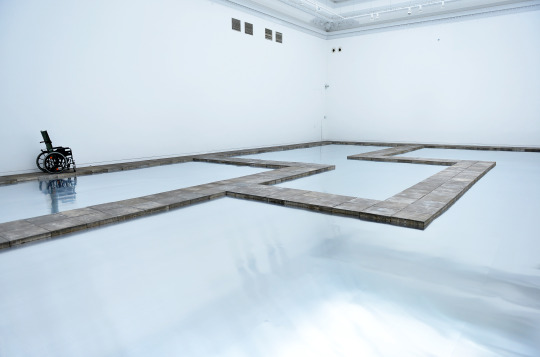
Koji Kamoji, „Cisza i wola życia”, instalacja, żródło: zacheta.art.pl
MOCAK. Kraków
Ojczyzna w sztuce
27 kwietnia 2018 – 30 września 2018
To już ósma wystawa z cyklu „… w sztuce”. Działalność muzeum zainaugurowała wystawa „Historia w sztuce”, potem przyszedł czas na sport, ekonomię, medycynę, zbrodnię, a w końcu „Sztukę w sztuce”. Pomysł aby sztukę współczesną posegregować według haseł spodobał się kuratorom i/lub publiczności.
Wystawa „Ojczyzna w sztuce” ma pomóc zredefiniować pojęcie ojczyzny i narodu, które nie pasują do dzisiejszego postkolonialnego świata. Są więc liczne przedstawienia flagi i symboli narodowych, są też prace odwołujące się do trudnych i wstydliwych momentów historii. Artyści pokazują też archaiczność pojęcia naród i ojczyzna. Piotr Wysocki sfilmował dzieci śpiewające słowa „nie będzie Niemiec pluł nam w twarz”, które dla młodego pokolenia nic już nie znaczą ale z pewnością zostaną zapamiętane. Z kolei Krzysztof Wodiczko pokazał polskich bohaterów narodowych mówiących głosem współczesnych aktywistów walczących o prawa różnych grup społecznych.
Więcej o wystawie: https://bit.ly/2HJGUJb
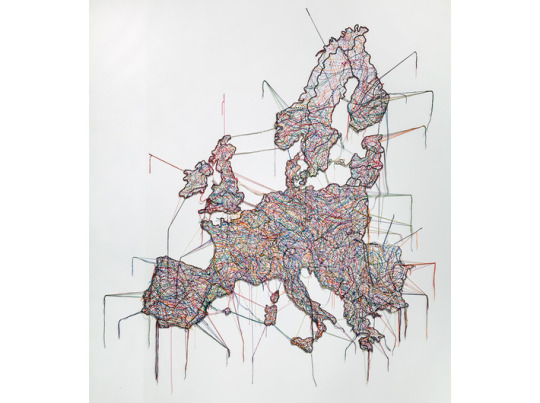
Małgorzata Markiewicz, Mapa, 2013, obiekt, 250 × 250 cm, Kolekcja MOCAK-u, fot.: R. Sosin, źródło: mocak.pl
Muzeum Narodowe w Krakowie, Gmach Główny
Z drugiej strony rzeczy. Polski dizajn po roku 1989
06 kwietnia 2018 – 19 sierpnia 2018
Otwarta w kwietniu wystawa poświęcona jest polskiemu dizajnowi po 1989 roku. Prezentuje polskie wzornictwo na tle przemian gospodarczych i kulturowych. Na wystawie zobaczymy eksponaty począwszy od lat 90, czyli czasów transformacji i zapaści gospodarczej kiedy to twórcy starali odnaleźć się w nowej rzeczywistości; kolejne lata to próba odpowiedzenia na potrzeby rynku ale również tzw. dizajn krytyczny, podejmujący ważne tematy społeczne.
Wśród wystawionych eksponatów znajdziemy sofy, krzesła, siedziska, ekspres do kawy, grzejnik, buty i zabawki.
Więcej o wystawie: https://bit.ly/2IpLV9F
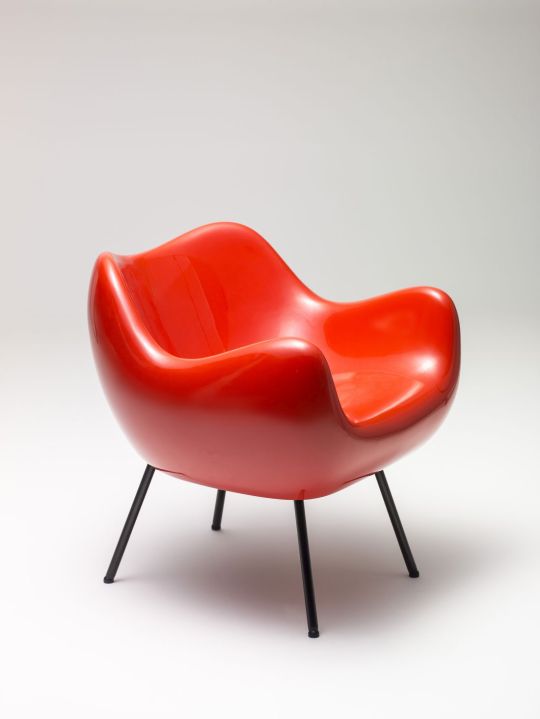
Fotel RM58 Classic, rojekt Roman Modzelewski (1912–1997), 1958, produkcja Vzór sp. z o.o., od 2012 / fot. Bartosz Cygan - Pracownia Fotograficzna MNK, źródło: mnk.pl
Muzeum Warmińskie w Lidzbarku Warmińskim
Fotografie Zdzisława Beksińskiego z kolekcji Muzeum Narodowego we Wrocławiu
08 czerwca 2018 – 07 października 2018
Na wystawie pokazano wybrane prace z kolekcji Muzeum Narodowego we Wrocławiu. Zdzisław Beksiński znany głównie ze swojej twórczości malarskiej, początkowo zajmował się fotografią. Fascynacja tym medium choć krótka, okazała się niezwykle owocna. W latach 1953-1959 powstało wiele wybitnych prac, a sporą z nich część Zdzisław Beksiński przekazał w darze Muzeum Narodowemu we Wrocławiu.
Beksiński tworzył portrety, kompozycje abstrakcyjne, montaże i akty. Dopełnieniem wielu fotografii jest sugestywny tytuł, który ma nasuwać określone skojarzenia. Już w tym okresie pojawiają się charakterystyczne dla późniejszego malarstwa artysty elementy: krzyże, nagrobki, samotna postać zagubiona pośród krajobrazu, więzy, twarz wykrzywiona z przerażenia.
Choć Beksiński zyskał uznanie jako fotografik, porzucił to medium w 1959 roku by nigdy już do niego nie powrócić. Tłumaczył potem, że czuł iż więcej w tej technice nie jest w stanie wyrazić.
Więcej o wystawie: https://bit.ly/2MxsHAV
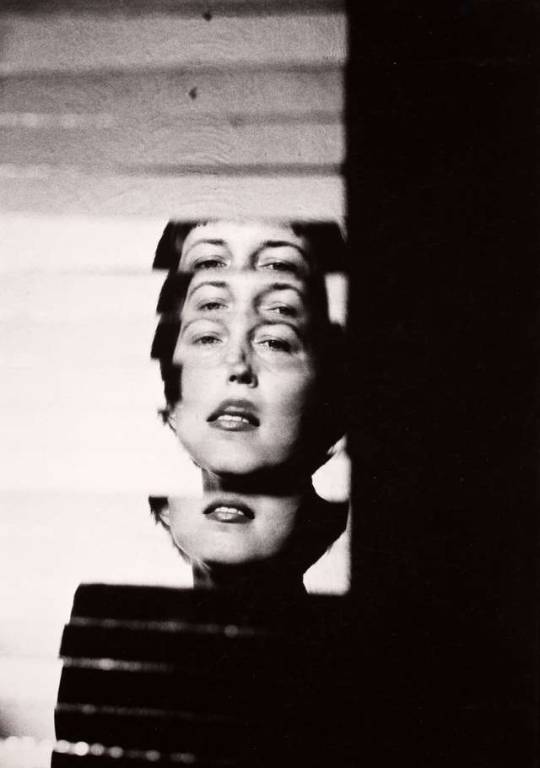
Zdzisław Beksiński, źródło: muzeum.olsztyn.pl
Muzeum Śląskie w Katowicach
Mirosław Bałka „[(.;,:?!–…)]”
11 listopada 2017 – 16 września 2018
Galeria jednego dzieła Muzeum Śląskiego to wielka przestrzeń mieszcząca się w holu głównym muzeum. Pokazano tu do tej pory trzy instalacje: „Modry” Leona Tarasewicza, „Mi’ma’amakim” Carole Benzaken oraz „Odbicie” Dani Karavana. Tym razem przestrzeń oddano Mirosławowi Bałce, kuratorką wystawy jest Anda Rottenberg.
Artysta zbudował wielką budowlę z blachy, która ma być trójwymiarowym odwzorowaniem rentgenowskiego zdjęcia klatki piersiowej z zarysem płuc.
Instalacja odwołuje się do miejsca w którym powstała - muzeum znajduje się na terenie dawnej kopalni. Wchodząc wgłąb budowli widz znajduje się w labiryncie ciemnych korytarzy przypominające wyrobiska górnicze. Korytarze mają zmienną wysokość i szerokość. Dodatkowo widz odbiera z otoczenia różnorodne bodźce oddziałujące na dotyk, wzrok, uczucie ciepła i zimna.
Jak przyznaje sam artysta, instalacja powstała z myślą o Śląsku i miała być próbą pochylenia się nad problemami regionu. Porusza problem zanieczyszczenia powietrza i zagrożeń związanych z górnictwem.
Więcej o wystawie: https://bit.ly/2lJUino
Pawilon Czterech Kopuł we Wrocławiu
Tu strzyka, tam łupie, ale rży. A sumienie kąsa. Tadeusz Brzozowski – inspiracje, konteksty, ślady.
22 kwietnia 2018 – 29 lipca 2018
Wystawę zorganizowano z okazji setnej rocznicy urodzin Tadeusza Brzozowskiego, jednego z najwybitniejszych artystów polskich XX wieku. Wystawa ma pokazać ewolucję twórczości artysty od dzieciństwa, przypadającego na lata dwudzieste, aż po okres przed jego śmiercią w 1987 roku. Przede wszystkim jednak ma przybliżyć twórczość artysty poprzez liczne rysunki, które najpierw służyły jako wstępne szkice by z czasem stać się skończonymi i pełnymi dziełami sztuki.
Obok nich na wystawie zobaczymy również grafiki, obrazy, projekty: scenograficzne, murali i tkanin.
Ale to nie wszystko. Sztukę Brzozowskiego, jak wskazuje tytuł wystawy, mamy szansę zobaczyć w znacznie szerszym kontekście - blisko 100 prac to dzieła artystów z którymi Brzozowski się przyjaźnił lub których twórczość była dla niego źródłem inspiracji. Pierwsza grupa to prace wybitnych artystów-przyjaciół: Aliny Szapocznikow, Magdaleny Abakanowicz, Tadeusza Kantora, Jerzego Tchórzewskiego, Władysława Hasiora i Antoniego Rząsy. Druga to dzieła artystów współczesnych i dawnych, które dla Brzozowskiego stanowiły inspirację: Tadeusza Makowskiego, Stanisława Ignacego Witkiewicza i Albrechta Dürera. Są też tańce śmierci i portrety trumienne.
W sumie na wystawie pokazano 300 prac pochodzących z okresu od XVI - XXI wieku.
Więcej o wystawie: https://bit.ly/2tPpSng

Tadeusz Brzozowski, Zycbad, 1969, źródło: pawilonczterechkopul.pl
Muzeum Narodowe w Krakowie
Gmach Główny
Teraz komiks!
2 marca 2018 – 22 lipca 2018
Sztuka komiksu, dotąd niezauważana przez instytucje wystawiennicze, wreszcie doczekała się osobnej wystawy, i to od razu w Gmachu Głównym krakowskiego Muzeum Narodowego. Wszystkie eksponaty są własnością Wojciecha Jamy - twórcy Muzeum Dobranocek w Rzeszowie. Jego ogromna kolekcja liczy 600 eksponatów, w tym albumy z rysunkami i autografami, szkice, plansze, blaudruki, a także książki, katalogi, czasopisma, druki ulotne, ponadto unikalne figurki, zabawki, monety, znaczki, przedmioty codziennego użytku.
Więcej o wystawie: https://bit.ly/2BYhOX9
3 notes
·
View notes
Text
POPULATION
Abounaddara Akinbode Akinbiyi Nevin Aladağ Danai Anesiadou Andreas Angelidakis Aristide Antonas Rasheed Araeen Ariuntugs Tserenpil Michel Auder Alexandra Bachzetsis Nairy Baghramian Sammy Baloji Arben Basha Rebecca Belmore Sokol Beqiri Roger Bernat Bili Bidjocka Ross Birrell Llambi Blido Nomin Bold Pavel Brăila Geta Brătescu Miriam Cahn María Magdalena Campos-Pons and Neil Leonard Vija Celmins Banu Cennetoğlu Panos Charalambous Nikhil Chopra Ciudad Abierta Marie Cool Fabio Balducci Anna Daučíková Moyra Davey Yael Davids Agnes Denes Manthia Diawara Beau Dick (1955–2017) Maria Eichhorn Hans Eijkelboom Bonita Ely Theo Eshetu Aboubakar Fofana Peter Friedl Guillermo Galindo Regina José Galindo Israel Galván, Niño de Elche, and Pedro G. Romero Daniel García Andújar Pélagie Gbaguidi Apostolos Georgiou Yervant Gianikian and Angela Ricci Lucchi Gauri Gill Marina Gioti Beatriz González Douglas Gordon Hans Haacke Constantinos Hadzinikolaou Irena Haiduk Ganesh Haloi Anna Halprin Dale Harding David Harding Maria Hassabi Edi Hila Susan Hiller Hiwa K Olaf Holzapfel Gordon Hookey iQhiya Sanja Iveković Amar Kanwar Romuald Karmakar Andreas Ragnar Kassapis Kettly Noël Bouchra Khalili Khvay Samnang Daniel Knorr Katalin Ladik Lala Rukh (1948–2017) David Lamelas Rick Lowe Alvin Lucier Ibrahim Mahama Narimane Mari Mata Aho Collective Mattin Jonas Mekas Angela Melitopoulos Phia Ménard Lala Meredith-Vula Gernot Minke Marta Minujín Naeem Mohaiemen Hasan Nallbani Joar Nango Rosalind Nashashibi and Nashashibi/Skaer Negros Tou Moria Otobong Nkanga Emeka Ogboh Olu Oguibe Rainer Oldendorf Pauline Oliveros (1932–2016) Joaquín Orellana Mejía Christos Papoulias Véréna Paravel and Lucien Castaing-Taylor Benjamin Patterson (1934–2016) Dan Peterman Angelo Plessas Nathan Pohio Pope.L Postcommodity Prinz Gholam R. H. Quaytman Gerhard Richter Abel Rodríguez Tracey Rose Roee Rosen Arin Rungjang Ben Russell Georgia Sagri Máret Ánne Sara Ashley Hans Scheirl Marilou Schultz David Schutter Algirdas Šeškus Nilima Sheikh Ahlam Shibli Zef Shoshi Mounira Al Solh Annie Sprinkle and Beth Stephens Eva Stefani K. G. Subramanyan (1924–2016) Vivian Suter El Hadji Sy Sámi Artist Group (Keviselie/Hans Ragnar Mathisen, Britta Marakatt-Labba, Synnøve Persen) Terre Thaemlitz Piotr Uklański Jakob Ullmann Antonio Vega Macotela Cecilia Vicuña Annie Vigier & Franck Apertet (les gens d’Uterpan) Wang Bing Lois Weinberger Stanley Whitney Elisabeth Wild Ruth Wolf-Rehfeldt Ulrich Wüst Zafos Xagoraris Sergio Zevallos Mary Zygouri Artur Żmijewski
Zainul Abedin (1914–1976) Stephen Antonakos (1926–2013) Arseny Avraamov (1886–1944) Ernst Barlach (1870–1938) Étienne Baudet (ca. 1638–1711) Samuel Beckett (1906–1989) Franz Boas (1858–1942) Arnold Bode (1900–1977) Lorenza Böttner (1959–1994) Marcel Broodthaers (1924–1976) Lucius Burckhardt (1925–2003) Abdurrahim Buza (1905–1986) Vlassis Caniaris (1928–2011) Sotir Capo (1934–2012) Cornelius Cardew (1936–1981) Ulises Carrión (1941–1989) Agim Çavdarbasha (1944–1999) Chittaprosad (1915–1978) Jani Christou (1926–1970) Chryssa (1933–2013) André du Colombier (1952–2003) Gustave Courbet (1819–1877) Christopher D’Arcangelo (1955–1979) Bia Davou (1932–1996) Maya Deren (1917–1961) Ioannis Despotopoulos (1903–1992) Thomas Dick (1877–1927) Carl Friedrich Echtermeier (1845–1910) Maria Ender (1897–1942) Forough Farrokhzad (1935–1967) Conrad Felixmüller (1897–1977) Pavel Filonov (1883–1941) Niccolò di Pietro Gerini (1340–1414) Tomislav Gotovac (1937–2010) Jacob and Wilhelm Grimm (1785–1863, 1786–1859) Ludwig Emil Grimm (1790–1863) Giovanni di ser Giovanni Guidi (1406–1486) Cornelia Gurlitt (1890–1919) Louis Gurlitt (1812–1897) Nikos Hadjikyriakos-Ghika (1906–1994) Oskar Hansen (1922–2005) Sedje Hémon (1923–2011) Theodor Heuss (1884–1963) Karl Hofer (1878–1955) Ralph Hotere (1931–2013) Albert Jaern (1893–1949) Iver Jåks (1932–2007) Sunil Janah (1918–2012) Alexander Kalderach (1880–1965) Tshibumba Kanda Matulu (1947–1981 disappeared) Leo von Klenze (1784–1864) Kel Kodheli (1918–2006) Louis Kolitz (1845–1914) Spiro Kristo (1936–2011) KSYME-CMRC (founded 1979) Anna “Asja” Lācis (1891–1979) Maria Lai (1919–2013) Yves Laloy (1920–1999) Valery Pavlovich Lamakh (1925–1978) George Lappas (1950–2016) Karl Leyhausen (1899–1931) Max Liebermann (1847–1935) George Maciunas (1931–1978) Ernest Mancoba (1904–2002) Oscar Masotta (1930–1979) Mikhail Matyushin (1861–1934) Pandi Mele (1939–2015) Tina Modotti (1896–1942) Benode Behari Mukherjee (1904–1980) Krzysztof Niemczyk (1938–1994) Ivan Peries (1921–1988) David Perlov (1930–2003) André Pierre (1915–2005) Dimitris Pikionis (1887–1968) Dmitri Prigov (1940–2007) Hasan Reçi (1914–1980) W. Richter Anne Charlotte Robertson (1949–2012) Erna Rosenstein (1913–2004) August Wilhelm and Friedrich Schlegel (1767–1845, 1772–1829) Bruno Schulz (1892–1942) Scratch Orchestra (1969–1974) Tom Seidmann-Freud (1892–1930) Allan Sekula (1951–2013) Baldugiin Sharav (1869–1939) Amrita Sher-Gil (1913–1941) Vadim Sidur (1924–1986) August Spies (1855–1887) Foto Stamo (1916–1989) Gani Strazimiri (1915–1993) Władysław Strzemiński (1893–1952) Alina Szapocznikow (1926–1973) Yannis Tsarouchis (1910–1989) Antonio Vidal (1928–2013) Albert Weisgerber (1878–1915) Lionel Wendt (1900–1944) Johann Joachim Winckelmann (1717–1768) Fritz Winter (1905–1976) Basil Wright (1907–1987) Andrzej Wróblewski (1927–1957) Ivan Wyschnegradsky (1893–1979) Iannis Xenakis (1922–2001) Androniqi Zengo Antoniu (1913–2000) Pierre Zucca (1943–1995)
Documenta14, 2017
12 notes
·
View notes
Text
Side by Side
Jankel Adler, Miroslaw Balka, Yael Bartana, Willi Baumeister, Krzysztof M. Bednarski, Joseph Beuys, Lucas Cranach the Elder, Albrecht Durer, Max Ernst, Jochen Gerz, Tadeusz Kantor, Edward Krasinski, Jacek Malczewski, Kazimir Malevich, Jan Matejko, Hans Maler zu Schwaz, Adolph Menzel, Deimantas Narkevicius, Gerhard Richter, Wilhelm Sasnalm, Gregor Schneider, Bruno Schulz, Daniel Schultz, Kurt Schwitters, Frank Stella, Franz von Stuck, Veit Stoss, Wladyslaw Strzeminski, Alina Szapocznikow, Leon Tarasewicz, Luc Tuymans, Piotr Uklanski, Andrzej Wajda, Krzysztof Wodiczko, Andrzej Wroblewski, Artur Zmijewski @ Gropius Bau, Berlin 23 Sep, 2011—9 Jan, 2012
Side by Side. Poland—Germany. A 1000 Years of Art and History is a project curated by Anda Rottenberg developed in collaboration between the Royal Castle in Warsaw and Martin-Gropius-Bau, Berlin. In this major exhibition, Poland and Germany look back at over one thousand years of shared history. From illuminated medieval manuscripts to contemporary artworks, this is the first presentation to illustrate the ten abiding ages of Polish-German neighbourhood, spanning over 700 objects, highlighting key social and political events, scientific discoveries, and cultural developments. Outstanding artworks, documents, books, films, photographs, and music are brought together to create a unique and powerful picture. Testifying to the vitality and multifaceted nature of mutual relations, Side by Side explores the role of history and representation by crafting national and cultural identities.
The exhibition is accompanied by an over 700-page comprehensive catalogue including essays by leading experts from Germany and Poland and other countries.
Curated by Anda Rottenberg
0 notes
Text

Alina Szapocznikow, 'Stela', 1968, polyurethane sponge, polyester resin, 79 x 46 x 69 cm.Courtesy of Piotr Stanislawski and Galerie Gisela Capitain GmbH, Cologne, photo WIELS | @abwwia
18 notes
·
View notes
Video
„II wojna światowa – dramat, symbol, trauma” | 'World War II – Drama, Sy...
Wystawa „II wojna światowa – dramat, symbol, trauma”
Artyści: Ryszard Apte, Mirosław Bałka, Krzysztof M. Bednarski, Edward Dwurnik, Wojciech Fangor, Ewa Faryaszewska, Zbigniew Grzybowski, Eugeniusz Haneman, Władysław Hasior, Maria Hiszpańska-Neumann, Lukáš Houdek, Elżbieta Janicka, Maria Jarema, Jane Korman, Paweł Kowalewski, Sigalit Landau, Thomas Lange, Zbigniew Libera, Bronisław Linke, Zbigniew Łagocki, Stefan Mrożewski, Marek Oberländer, Zdzisław Pabisiak, Krystyna Piotrowska, Piotr Saul, Agata Siwek, Klaus Staeck, Witold Stelmachniewicz, Jonasz Stern, Władysław Strzemiński, Łukasz Surowiec, Józef Szajna, Alina Szapocznikow, Roman Tarkowski, Mieczysław Wątorski, Leon Wróblewski, Kazimierz Gustaw Zemła, Artur Żmijewski, Andrzej Żygadło
Czas trwania wystawy: 25.10.2019–22.3.2020
Kuratorzy: Maria Anna Potocka, Martyna Sobczyk
Koordynator: Mirosława Bałazy
Miejsce: Budynek A, poziom 0
Tworząc wystawę na temat II wojny światowej, nie mieliśmy ambicji przedstawienia jej historii. Skupiliśmy się na kilku kwestiach, które szczególnie mocno odcisnęły się w świadomości Polaków.
0 notes
Text
Peeling Back the Layers of Alina Szapocznikow’s Bodily Sculptures
Peeling Back the Layers of Alina Szapocznikow’s Bodily Sculptures
Alina Szapocznikow “Glowa Piotra (Head of Piotr)” (1972), polyester resin, 18 1/2 x 17 3/4 x 8 1/4 inches, © ADAGP, Paris (all images courtesy the Estate of Alina Szapocznikow / Piotr Stanislawski / Galerie Loevenbruck, Paris / and Hauser & Wirth, photo by Thomas Barratt)
“Yeah, you spent your entire childhood there [in Warsaw], right?” reads the subtitle on a video playing the disembodied voice…
View On WordPress
0 notes
Text
Hauser & Wirth Announces Representation of Alina Szapocznikow
Hauser & Wirth Announces Representation of Alina Szapocznikow
NEW YORK—Hauser & Wirth announced its worldwide representation of The Estate of Alina Szapocznikow in collaboration with Piotr Stanislawski, the artist’s son, and Galerie Loevenbruck, Paris.
The artist posing amidst her work in her Malakoff studio, 1967 Photo by Antoni Miralda, © 2011 Artists Rights Society (ARS), New York/VEGAP, Madrid
Born in Poland to a Jewish family in 1926, Szapocznikow…
View On WordPress
0 notes
Text
Spoight on... Alina Szapocznikow
Spoight on… Alina Szapocznikow
© ADAGP, Paris Courtesy the Estate of Alina Szapocznikow / Piotr Stanislawski / Galerie Loevenbruck, Paris / Hauser & Wirth Photo: Fabrice Gousset, courtesy Galerie Loevenbruck, Paris Alina 13 04 11 99623 Cendrier de célibataire I (The Bachelor’s Ashtray I) 1972 Colored polyester resin and cigarette butts
Disembodied heads, desk lamp lips, breasts in ashtrays and desert bowls, Alina…
View On WordPress
0 notes
Photo

The Estate of Alina Szapocznikow, Ceramika II, Ceramika I et Ceramika III (1965). Terracotta. © ADAGP, Paris. Courtesy the Estate of Alina Szapocznikow / Piotr Stanislawski / Galerie Loevenbruck, Paris / and Hauser & Wirth. Photo: Fabrice Gousset.
29 notes
·
View notes